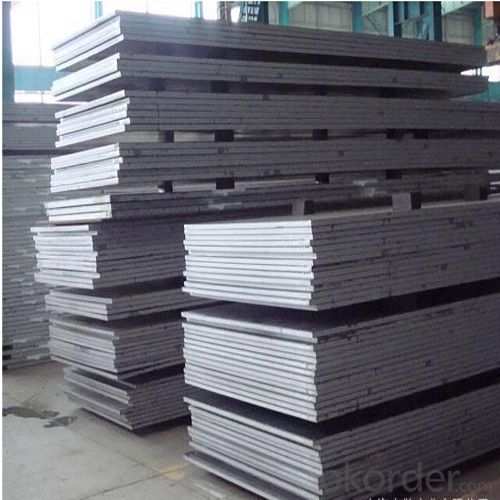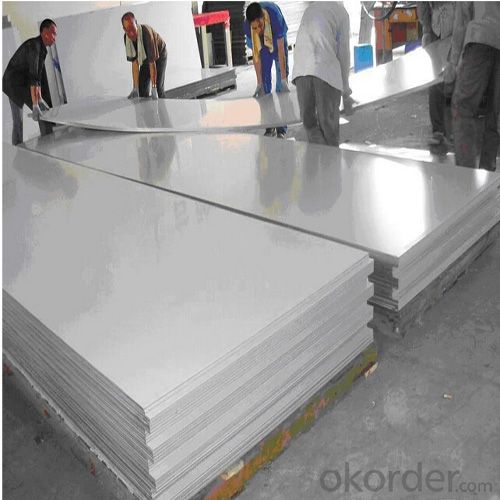Consumer Electronics Casings Aluminium with Best Price
- Loading Port:
- Shanghai
- Payment Terms:
- TT OR LC
- Min Order Qty:
- 5 m.t.
- Supply Capability:
- 10000 m.t./month
OKorder Service Pledge
OKorder Financial Service
You Might Also Like
Item specifice
1.Structure of Consumer Electronics Casings Aluminium Description:
Zinc is the main alloying elements in 7075, adds to the 3%-7.5% of zinc-containing alloys of magnesium, can form the strengthening effect of MgZn2, make the alloy heat treatment effect than on the aluminum-zinc alloy. Improve the content of zinc and magnesium alloys, the tensile strength will be further improved, but its resistance to stress corrosion and spalling corrosion will decline. Subjected to heat treatment and can reach very high strength characteristics. 7075 material is generally a small amount of copper, chrome, alloy, the 7075T651 aluminum alloy is the top grade, known as the most excellent products in aluminum alloy, high strength, far better than any mild steel.
2.Main Features of Consumer Electronics Casings Aluminium:
PVC Protect Film
Waterproof paper
High Quality
Competitive Price
3. Consumer Electronics Casings Aluminium Images:



4. Consumer Electronics Casings Aluminium Specification:
Standard | GB/T3190-2008, GB/T3880-2006, ASTM B209, JIS H4000-2006 .etc |
Thickness | 0.2-200mm aluminium 5050 H38 |
Width | 1250mm 1000mm or as your requirements |
Length | 3000mm 5800mm or as your requirements |
MOQ | 5 Ton |
Package | Standard export package, by wooden box or as require |
5.FAQ
Q1.How long have you been in this product?
A1:More than 10 years.
Q2. What's the minium quantity(MOQ)?
A2. 5 Metric tons
Q3. How long is shipping time?
A3. 7 (ready-made products)-25 days(OEM)
Q4. How do you guarantee the quality?
A4. 1. Cooperating and Exchaning experience with sevral quoted aluminum companies
2. Japanese and Swiss production line and skilled works (regular training and testing)
3. more than 10 years production experience.
Q5. Do you have after sale service?
A5. Yes. Any quality problem occurs within one year, pls take photoes,we will be responsible.
- Q:What is the hardness of aluminum sheets?
- The hardness of aluminum sheets can vary depending on the specific alloy and tempering process used, but generally, aluminum sheets have a relatively low hardness compared to other metals.
- Q:Q. Calculate the number of aluminium ions present in 0.051 g of aluminium oxide.( Hint: The mass of an ion is the same as that of an atom of the same element. Atomic mass of Al = 27 u) Please Explain each and every step!!!Thankx..A lot !!
- The formula for aluminium oxide is Al2O3 Its molecular weight is 2*27+3*16= 54+48 =102 Now, 102g of Al2O3 contains 2*6.023*10^23 number of Al ions so 1g contains (2*6.023*10^23)/102 number of Al ions so 0.051g Al2O3 contain (2*6.023*10^23)/102 *0.051 number of Al ions which is equal to 6.023*10^23*10^-3 = 6.023*10^20 number of Al ions(Answer)
- Q:How do I choose the right thickness for my aluminum sheet?
- When choosing the right thickness for your aluminum sheet, there are several factors you should consider. Firstly, you need to determine the specific application or purpose for which you will be using the aluminum sheet. Different projects may require different thicknesses based on the structural or aesthetic requirements. For instance, if you are using aluminum sheets for roofing or siding, a thicker gauge might be necessary to provide sufficient durability and resistance to weather conditions. Secondly, you should consider the level of strength and rigidity required. Thicker aluminum sheets generally offer greater strength and stability, which is crucial for applications such as construction or automotive components. However, keep in mind that thicker sheets may also be heavier and more difficult to work with, so consider the practicality and weight limitations of your project. Additionally, it is important to think about the size of the aluminum sheet you need. Larger sheets may require thicker gauges to maintain their structural integrity, while smaller sheets may not need as much thickness. Lastly, consider your budget. Thicker aluminum sheets can be more expensive due to the increased material cost and manufacturing process. Strike a balance between the required thickness and your budget constraints to ensure you make a cost-effective decision. In summary, choosing the right thickness for your aluminum sheet involves considering the specific application, required strength, size, and budget. It is recommended to consult with industry experts or suppliers who can provide guidance and advice based on your specific needs.
- Q:How does aluminum sheet perform in corrosive environments?
- Aluminum sheet performs exceptionally well in corrosive environments due to its inherent corrosion resistance. When exposed to moisture or various chemicals, aluminum forms a protective oxide layer that prevents further corrosion. This makes it a preferred choice for applications where resistance to corrosion is crucial, such as marine environments, chemical processing plants, and outdoor structures.
- Q:Can aluminum sheet be used for automotive heat shields?
- Indeed, aluminum sheet is a suitable option when it comes to automotive heat shields. The automotive industry favors aluminum due to its impressive thermal conductivity and remarkable heat resistance. By reflecting and dispersing heat away from specific regions, it effectively safeguards delicate components from excessive temperatures. Moreover, aluminum possesses the advantages of being lightweight and resistant to corrosion, rendering it an optimal choice for automotive purposes. It finds widespread utilization in diverse heat shield configurations, encompassing exhaust, engine, and under-carriage heat shields.
- Q:Are 101 aluminum sheets suitable for heat sinks?
- No, 101 aluminum sheets are not suitable for heat sinks. Heat sinks are designed to dissipate heat and therefore require materials with high thermal conductivity. 101 aluminum has a lower thermal conductivity compared to other aluminum alloys commonly used for heat sinks, such as 6061 or 6063. These alloys have better thermal conductivity properties, allowing them to effectively transfer heat away from the heat source. Therefore, it is recommended to use aluminum alloys specifically designed for heat sinks to ensure optimal heat dissipation and cooling performance.
- Q:Are aluminum sheets suitable for artistic sculptures?
- Aluminum sheets, indeed, prove to be a suitable choice for artistic sculptures. Boasting versatility, aluminum offers numerous benefits for sculpting endeavors. First and foremost, its lightweight nature makes it easier for artists to handle and manipulate. This quality grants them the ability to fashion intricate and detailed sculptures without compromising on structural integrity. Moreover, aluminum possesses high malleability, allowing it to be molded into diverse forms and contours. This grants artists the freedom to experiment with various designs and achieve their desired artistic expression. Additionally, aluminum's resistance to corrosion and weathering makes it an ideal material for outdoor sculptures. Its durability ensures that the artwork will withstand the elements and maintain its aesthetic appeal over time. Furthermore, aluminum sheets can be effortlessly welded or joined together, enabling artists to create larger and more intricate sculptures. All in all, aluminum sheets furnish artists with a flexible and long-lasting material that nurtures creativity and guarantees longevity in their sculptural masterpieces.
- Q:How do you remove stains or marks from aluminum sheets?
- To effectively eliminate stains or marks on aluminum sheets, the following steps can be followed: 1. Begin by preparing a mixture of warm water and mild dish soap in a bucket or basin. 2. Immerse a soft cloth or sponge into the soapy water and gently scrub the affected area. It is important to avoid the use of abrasive materials or harsh chemicals that may cause scratches or damage to the aluminum surface. 3. In case of more stubborn stains, a paste can be created by combining baking soda with water. Apply the paste onto the stained area and allow it to sit for a few minutes before softly scrubbing it with a cloth or sponge. 4. If the stains persist, consider utilizing a non-abrasive cleaner specifically designed for aluminum surfaces. Adhere to the instructions provided by the manufacturer on the packaging for optimal outcomes. 5. Thoroughly rinse the aluminum sheet with clean water to eliminate any remnants of soap. 6. For particularly stubborn stains or marks that prove to be difficult to remove, white vinegar or lemon juice can be employed. Apply a small amount of vinegar or lemon juice onto a cloth or sponge and gently rub the stained area. Rinse the aluminum sheet thoroughly after utilizing these acidic solutions. 7. After the cleaning process, it is crucial to completely dry the aluminum sheet to prevent the formation of water spots or streaks. This can be achieved by using a clean towel or allowing the sheet to air dry. Always remember to test any cleaning solution or method on a small, inconspicuous area of the aluminum sheet before applying it to the entire surface. This will help ensure that no damage or discoloration occurs.
- Q:Can aluminum sheets be used for battery enclosures?
- Yes, aluminum sheets can be used for battery enclosures. Aluminum is a widely used material for battery enclosures due to its excellent properties. It is lightweight, corrosion-resistant, and has good conductivity. These characteristics make it suitable for protecting batteries and ensuring their optimal performance. Aluminum's high strength-to-weight ratio also allows for the construction of sturdy yet lightweight enclosures, making it an ideal choice for various battery applications. Additionally, aluminum is easily recyclable, making it an environmentally friendly option. Overall, aluminum sheets are a viable and commonly used material for battery enclosures.
- Q:im wanting to try and source my own chemicals for experiments and such in the cheapest way possiblei thought a cheap method of making powdered aluminium would be to just sandpaper aluminium kitchen foil and collect the powder, what i need to know is:how pure is aluminium foil?.....e.g is it actually mixed with some other metals and is an alloyand will the powder i collect be as good as bottled aluminium powder? i know it wont be perfect but as long as its similar that should be fineim using it for pyrotechnical experiments by the way
- Aluminum foil is pretty pure for most purposes (99.1 % pure). However, I really think sandpapering aluminum foil is not your best option. For one, aluminum foil is quite expensive, I wonder if you could just get a bunch of the powder for a cheaper price than buying an equal mass of aluminum foil. Also, how would you even begin sandpapering it? If you rub a crumpled up ball of aluminum on a rough surface, you don't get a powder, you just get a ripped up ball and a gray mark on the rough surface. But you could try, tell me if it works. However, I think you may have better odds with aluminum cans. They are cheaper and thicker thus not so prone to ripping. Although I still doubt you could get a reasonable quantity of aluminum powder from that. If all else fails, you could always try stuffing a bunch of aluminum foil in a blender.
1. Manufacturer Overview |
|
|---|---|
| Location | |
| Year Established | |
| Annual Output Value | |
| Main Markets | |
| Company Certifications | |
2. Manufacturer Certificates |
|
|---|---|
| a) Certification Name | |
| Range | |
| Reference | |
| Validity Period | |
3. Manufacturer Capability |
|
|---|---|
| a)Trade Capacity | |
| Nearest Port | |
| Export Percentage | |
| No.of Employees in Trade Department | |
| Language Spoken: | |
| b)Factory Information | |
| Factory Size: | |
| No. of Production Lines | |
| Contract Manufacturing | |
| Product Price Range | |
Send your message to us
Consumer Electronics Casings Aluminium with Best Price
- Loading Port:
- Shanghai
- Payment Terms:
- TT OR LC
- Min Order Qty:
- 5 m.t.
- Supply Capability:
- 10000 m.t./month
OKorder Service Pledge
OKorder Financial Service
Similar products
New products
Hot products
Hot Searches
Related keywords






























